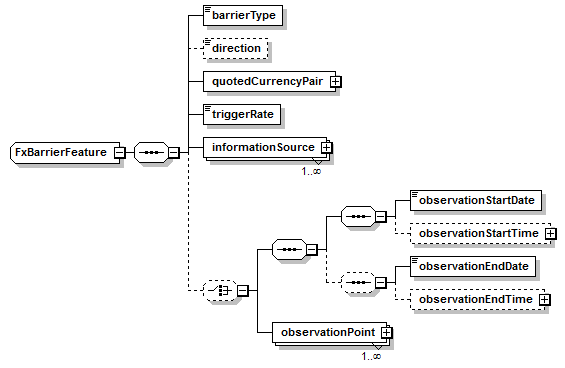
Namespace: |
|
Content: |
complex, 10 elements |
Defined: |
globally in fpml-fx-5-8.xsd; see XML source |
Includes: |
definitions of 10 elements |
Used: |
at 2 locations |

XML Representation Summary |
|||||
<...> |
|||||
|
|||||
</...> |
|||||
|
<xsd:sequence>
<xsd:element name="barrierType" type="FxBarrierTypeEnum"/>
<xsd:choice minOccurs="0">
<xsd:sequence>
<xsd:sequence>
</xsd:sequence>
<xsd:sequence minOccurs="0">
</xsd:sequence>
</xsd:sequence>
<xsd:element maxOccurs="unbounded" minOccurs="1" name="observationPoint" type="FxBusinessCenterDateTime"/>
</xsd:choice>
</xsd:sequence>
</xsd:complexType>
|
Type: |
FxBarrierTypeEnum, simple content |
|
enumeration of xsd:token
|
Enumeration: |
|
||||||||||||
minLength: |
0
|
Type: |
FxBarrierDirectionEnum, simple content |
|
enumeration of xsd:token
|
Enumeration: |
|
||||||
minLength: |
0
|
Type: |
InformationSource, complex content |
Type: |
xsd:date, predefined, simple content |
Type: |
BusinessCenterTime, complex content |
Type: |
FxBusinessCenterDateTime, complex content |
|
<xsd:element maxOccurs="unbounded" minOccurs="1" name="observationPoint" type="FxBusinessCenterDateTime"/>
|
Type: |
xsd:date, predefined, simple content |
Type: |
BusinessCenterTime, complex content |
Type: |
QuotedCurrencyPair, complex content |
Type: |
PositiveDecimal, simple content |
|
xsd:decimal
|
minExclusive: |
0
|
|
XML schema documentation generated with DocFlex/XML 1.9.0 using DocFlex/XML XSDDoc 2.8.0 template set. All content model diagrams generated by Altova XMLSpy via DocFlex/XML XMLSpy Integration.
|